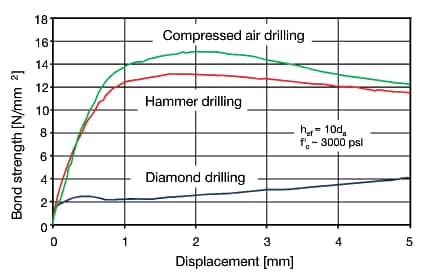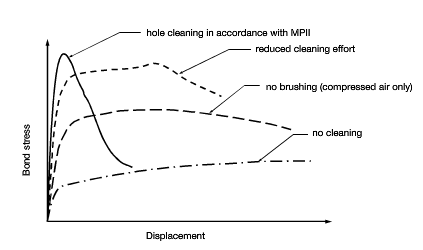
6 steps to perfect rebar installation

Step 1: Locate existing reinforcement and other embedded items
The location of existing reinforcement is generally accomplished with one or more scanning methods. These may be generally categorized as:
a) Scanners that locate ferrous materials using magnetic fields (ferrous scanners, see Figure 21)
b) Scanners that utilize GPR (ground-penetrating radar technology)
c) X-ray scanning equipment
For reinforcing bars located within 8-10 inches of the concrete surface, ferrous scanners provide both bar location and size. For location of both ferrous and non-ferrous embedded items (e.g., aluminum conduit), GPR-based scanners are appropriate. For areas of heavy congestion or where existing reinforcing is too deep for ferrous or GPR systems, x-ray scanning methods may be necessary. Where available, it is generally preferable to supplement scanning results with as built or original design documents.

Step 2: Roughen the existing concrete surface
Surface roughening prior to casting new concrete against existing provides not only for increased adhesion, but also increases the ability of the joint to transfer shear through shear friction. Where new concrete is to be applied to an existing concrete surface, roughening of the existing concrete surface is typically specified. In cases where the surface layer of existing concrete is carbonated, the carbonated layer should be removed in areas that are to receive post-installed reinforcing bars. A rule of thumb is to remove the carbonated concrete over a circular area given by the diameter of the bar plus 2-1/2 inches.
ACI 318-11Section 11.6.9 requires roughening "...to a full amplitude of approximately 1/4 in." This may be accomplished by mechanical means (e.g., using a Hilti TE 76ATC equipped with a bushing tool), sand-blasting or water-blasting. It should be ascertained that the resulting surface does not contain loose material prior to placing new concrete.

Step 3: Choose a drilling method
To satisfy development length requirements, post-installed reinforcing bars are usually associated with deeper embedments, and therefore longer drilled holes, than adhesive anchors. One of the following three drilling methods is typically employed:
• rotary-impact drills (hammer drills) equipped with standard or cruciform carbide bits or with Hilti Hollow Drill Bits (HDB)
• percussive rock drills
• diamond core drills utilizing either wet or dry coring technology
Each method is associated with advantages and disadvantages. In the absence of drilling guidance tools, and where alignment aids or other techniques to maintain drilling accuracy are not used, the following relationships may be used to account for possible deviation of the drilled hole from its intendedpath:
Hammer-drilledholes:
c min,req =1.2+ 0.06 ℓ d ≥ 2d b (in.) [2]
Compressed-air (rock) drilled holes:
c min,req =2.0+ 0.08 ℓ d ≥ 2d b (in.) [3]
Drill stand (e.g., core-drilled holes):
c min,req =1.2+ 0.02 ℓ d ≥ 2d b (in.) [4]
where,
ℓ d is the hole length in inches; and
d b is the diameter of the reinforcing bar in inches
c min,req is the distance from the concrete edge to the face of the drill bit

Hammer drills are readily available and are the preferred approach for most applications given their portability and ease of use. Hilti hammer drills produce a non-uniform hole surface especially suitable for enhancing bond (provided correct hole cleaning procedures are used). For longer holes, hammer drills may not be practical; they are also not always suitable for drilling through embedded steel where this is required.
The Hilti SafeSet™ system consists of Hollow Drill Bits (HDB) used in combination with Hilti Vacuum Cleaners (VC 40-Uor VC 20-U). Hilti HDBs utilize the same state-of-the-art carbide drilling technology as Hilti TE-CX and Hilti TE-YX bits and they comply with the ANSI B212.15 standard for carbide drill bit dimensions. The Hilti SafeSet system performs equally well in dry or wet concrete.

Rock drills offer speed and efficiency and produce a rough hole surface that is suitable for bond, but the larger impact energy associated with rock drills may increase the tendency for damage in the concrete member, particularly if used in applications with small edge distance or reduced backside cover. Rock drills typically require larger edge distances/ member thickness. For applications involving rock drilled holes, contact Hilti.
For longer embedment depths, core drills are generally the preferred option. In contrast to hammer drills, which fracture the concrete with impact energy, core drill bits utilize a sacrificial matrix containing diamond fragments to abrade the concrete. Hilti diamond core bits with laser-welded segments offer long life and exceptional drilling efficiency. Using extensions, core drills can produce very long, straight holes. The stiffness of the core barrel permits holes to be drilled with less deviation from the intended path, and they are capable of drilling through embedded steel without great effort. On the other hand, where the existing reinforcing must be protected (e.g., as in the case of pre-stressing tendons), this feature of core drilling maybe a liability. More importantly, core drills typically produce a very smooth hole that is usually covered with a thin film deleterious to bond. Accordingly, core drilled holes must be thoroughly cleaned prior to injecting adhesive. Note also that some adhesive systems are not suitable for use with core drilled holes. For qualified systems, specific hole cleaning procedures have been developed to optimize bond under these conditions, and are detailed in the Hilti Instructions for Use (generically, these instructions are known as the Manufacturer’s Printed Installation Instructions, or MPII).
The following figure illustrates the potential influence of drilling method on the load-displacement behavior of a post-installed reinforcing bar at shallow embedment. Where the drilling method to be used has not been predetermined, it is advisable to use an adhesive that is suitable for all drilling methods (e.g. Hilti HIT-RE 500 V3)

Step 4: Hole cleaning
Bond between adhesive and concrete is directly influenced by the condition of the hole wall at the time of adhesive injection. The concrete in which the post-installed reinforcing bar is to be installed may be dry, saturated or even partially or completely submerged at the time of installation.
Where installation in water-saturated or submerged concrete is required, check that the adhesive system to be used is qualified for these conditions.
Wet diamond core drilling will necessarily result in a damp environment in the drilled hole. Hole cleaning generally involves a water-cleaning process, followed by sequential blowing out the hole with compressed air to remove debris and water, and the use of a wire brush to mechanically scour the hole wall.


All cleaning procedures finish with the use of compressed air. (It is important to note that the use of compressed air may produce flying debris— eye protection should be worn at all times.)
The importance of hole cleaning as specified in the Hilti Instructions for Use for the performance of post-installed reinforcing bars is indicated in the figure below. For cases where adherence to multi-step hole cleaning procedures may not be possible, use of Hilti SafeSet™ technology with Hilti Hollow Drill Bits (HDB) is recommended.

Hilti provides a number of accessories for cleaning deep drilled holes in accordance with the Instructions for Use. These include matched-tolerance wire brushes, brush extensions for long holes, attachments to facilitate power brushing, air wands, hose extensions, couplers and air nozzles. Hilti Profi Rebar Accessory Sets provide the necessary additional components for installation of post-installed reinforcing bars in a single package.

Step 5: Injection of the adhesive
The objective of adhesive injection is to achieve a void-free installation. Aside from reducing bond area and inhibiting cure, air voids in the injected adhesive may lead to increased effort associated with bar installation and can cause uncontrolled ejection of the adhesive from the hole during bar installation as air is forced out of the adhesive matrix.
In order to inject the adhesive with minimal air voids in drilled holes, the Hilti injection system utilizes matched-tolerance piston plugs. The Hilti piston plug system provides positive feedback to the operator for controlling the injection process through the pressure of the adhesive on the plug and has been shown to dramatically improve injection quality and efficiency.
Dispensing equipment used for injection is generally selected as a function of bar size and orientation, ambient temperature conditions and accessibility.


Step 6: Bar installation
Smaller bar diameters can be inserted in a vertical downward direction with (relatively) minimal effort. Large-diameter bars in horizontal and upward-inclined orientations may require substantial effort to lift and insert the reinforcing bar into the adhesive-filled hole. In all cases, it is advisable to test the fit of the bar in the hole prior to injecting adhesive.
For overhead installations, particularly of larger diameter bars, provision must be made for securing the bar during adhesive cure. In addition, certification requirements for installers performing installation of bars to carry sustained tension loads, as well as additional special inspection requirements, may apply.

Options for the installation of post-installed reinforcing bars include cementitious grouts, polymer adhesives, and hybrid systems that combine cementitious components with polymers. The use of cementitious (e.g., baseplate) grouts is typically limited to down-hole applications. Adhesives (sometimes referred to as thixotropic adhesives) that have the correct viscosity to provide a void-free bond layer in the annular space between the bar and the concrete while still resisting unrestricted flow have been developed specifically for anchoring and bar embedment. These systems permit installation at all orientations with superior bond strength under a variety of use conditions. The proper selection of the system is dependent on a number of job-specific parameters.
Please visit our Rebar Design Center for information regarding post-installed rebar applications.
Hilti is the first manufacturer to offer a software solution for the post-installed rebar application. PROFIS Rebar is a web based design software that allows engineers to design post-installed rebar using the only two approved adhesive anchor systems on the market, HIT-HY 200 and HIT-RE 500 V3. PROFIS Rebar calculates tension and compression lap splice lengths, development lengths for starter bars, development lengths for special moment frames and special structural walls, and development lengths for shear dowels. PROFIS Rebar also calculates post-installed reinforcing bar embedment based on research conducted using shear friction theory.

